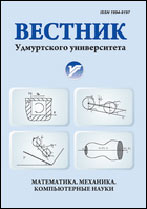|
This article is cited in 8 scientific papers (total in 8 papers)
MATHEMATICS
On the solution of an inverse boundary value problem for composite materials
V. P. Tananaab, A. A. Ershovac
a Chelyabinsk State University, ul. Brat’ev
Kashirinykh, 129, Chelyabinsk, 454001, Russia
b South Ural State University, pr. Lenina, 76, Chelyabinsk, 454080, Russia
c Institute of Mathematics
and Mechanics, Ural Branch of the Russian Academy of Sciences, ul. S. Kovalevskoi, 16, Yekaterinburg,
620219, Russia
Abstract:
In the present paper, an inverse boundary value problem of thermal conduction is formulated, posed and solved, provided that the thermal diffusivity is piecewise constant. This task holds a prominent place in technology, since thermally loaded units of technical constructions are covered with a heat insulating layer, the thermal characteristics of which are very different from the thermal characteristics of the structure itself. Such tasks are used in the planning of bench tests of aircraft. Modern composite materials solve this problem, giving developers a number of advantages. In rocket engines, the inner wall of the internal combustion chamber is covered with a heat-shielding layer, which is made of composite materials. Due to the properties of these materials, the heat-shielding layer significantly reduces the temperature of the internal combustion wall. When solving an inverse boundary problem, it is necessary to take into account the difference in the thermal conductivity coefficients of the component parts of composite materials, which make the wall of the chamber. The problem was investigated using a Fourier series in eigenfunctions for an equation with a discontinuous coefficient. It is proved that for the solution of the inverse problem the Fourier transform with respect to $t$ is applicable. To solve the inverse problem, the Fourier transform was used, which made it possible to reduce the inverse problem to the operator equation, which was solved by the discrepancy method.
Keywords:
projection regularization method, inverse problem of thermal conduction, piecewise constant thermal diffusivity.
Received: 01.10.2018
Citation:
V. P. Tanana, A. A. Ershova, “On the solution of an inverse boundary value problem for composite materials”, Vestn. Udmurtsk. Univ. Mat. Mekh. Komp. Nauki, 28:4 (2018), 474–488
Linking options:
https://www.mathnet.ru/eng/vuu652 https://www.mathnet.ru/eng/vuu/v28/i4/p474
|

|




 Contact us:
Contact us: Terms of Use
Terms of Use
 Registration to the website
Registration to the website Logotypes
Logotypes








 Citation in format
Citation in format 
